Valhalla
_by_Max_Br%C3%BCckner.jpg)
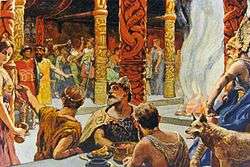
In Norse mythology, Valhalla (from Old Norse Valhöll "hall of the slain"[1]) is a majestic, enormous hall located in Asgard, ruled over by the god Odin. Chosen by Odin, half of those who die in combat travel to Valhalla upon death, led by valkyries, while the other half go to the goddess Freyja's field Fólkvangr. In Valhalla, the dead join the masses of those who have died in combat known as Einherjar, as well as various legendary Germanic heroes and kings, as they prepare to aid Odin during the events of Ragnarök. Before the hall stands the golden tree Glasir, and the hall's ceiling is thatched with golden shields. Various creatures live around Valhalla, such as the stag Eikþyrnir and the goat Heiðrún, both described as standing atop Valhalla and consuming the foliage of the tree Læraðr.
Valhalla is attested in the Poetic Edda, compiled in the 13th century from earlier traditional sources, the Prose Edda, written in the 13th century by Snorri Sturluson, Heimskringla, also written in the 13th century by Snorri Sturluson, and in stanzas of an anonymous 10th century poem commemorating the death of Eric Bloodaxe known as Eiríksmál as compiled in Fagrskinna. Valhalla has inspired various works of art, publication titles, popular culture references, and has become a term synonymous with a martial (or otherwise) hall of the chosen dead.
Attestations
Poetic Edda
Valhalla is referenced at length in the Poetic Edda poem Grímnismál, and Helgakviða Hundingsbana II, while Valhalla receives lesser direct references in stanza 33 of the Völuspá, where the god Baldr's death is referred to as the "woe of Valhalla",[2] and in stanzas 1 to 3 of Hyndluljóð, where the goddess Freyja states her intention of riding to Valhalla with Hyndla, in an effort to help Óttar, as well as in stanzas 6 through 7, where Valhalla is mentioned again during a dispute between the two.[3]
Grímnismál
In stanzas 8 to 10 of Grímnismál, the god Odin (in the guise of Grímnir) states that Valhalla is located in the realm of Glaðsheimr. Odin describes Valhalla as shining and golden, and that it "rises peacefully" when seen from afar. From Valhalla, every day Odin chooses from those who have died in combat. Valhalla has spear-shafts for rafters, a roof thatched with shields, coats of mail are strewn over its benches, a wolf hangs in front of its west doors, and an eagle hovers above it.[4]
From stanzas 22 to 24, more details are given by Odin about Valhalla: the holy doors of the ancient gate Valgrind stand before Valhalla, Valhalla has five hundred and forty doors that eight hundred men can exit from at once (from which the einherjar will flow forth to engage the wolf Fenrir at Ragnarök). Within Valhalla exists Thor's hall Bilskirnir, and within it exist five hundred and forty rooms, and of all the halls within Valhalla, Odin states that he thinks his son's may be greatest.[5] In stanzas 25 through 26, Odin states that the goat Heiðrún and the hart Eikþyrnir stand on top of Valhalla and graze on the branches of the tree Læraðr. Heiðrún produces vats of mead that liquor cannot be compared to, and from Eikþyrnir's antlers drip liquid into the spring Hvergelmir from which flows forth all waters.[5]
Helgakviða Hundingsbana II
In stanza 38 of the poem Helgakviða Hundingsbana II, the hero Helgi Hundingsbane dies and goes to Valhalla. In stanza 38, Helgi's glory there is described:
- So was Helgi beside the chieftains
- like the bright-growing ash beside the thorn-bush
- and the young stag, drenched in dew,
- who surpasses all other animals
- and whose horns glow against the sky itself.[6]
Prose follows after this stanza, stating that a burial-mound was made for Helgi, and that when Helgi arrived in Valhalla, he was asked by Odin to manage things with him. In stanza 39, Helgi, now in Valhalla, has his former enemy Hunding—also in Valhalla—do menial tasks; fetching foot-baths for all of the men there, kindling fire, tying dogs, keeping watch of horses, and feeding the pigs before he can get any sleep. In stanzas 40 to 42, Helgi has returned to Midgard from Valhalla with a host of men. An unnamed maid of Sigrún, Helgi's valkyrie wife, sees Helgi and his large host of men riding into the mound. The maid asks if she is experiencing a delusion, if Ragnarök has begun, or if Helgi and his men have been allowed to return.[6]
In the stanzas that follow, Helgi responds that none of these things have occurred, and so Sigrún's maid goes home to Sigrún. The maid tells Sigrún that the burial mound has opened up, and that Sigrún should go to Helgi there, as Helgi has asked her to come and tend his wounds, which have opened up and are bleeding. Sigrún goes into the mound, and finds that Helgi is drenched in gore, his hair is thick with frost. Filled with joy at the reunion, Sigrún kisses him before he can remove his coat of mail, and asks how she can heal him. Sigrún makes a bed there, and the two sleep together in the enclosed burial mound. Helgi awakens, stating that he must "ride along the blood-red roads, to set the pale horse to tread the path of the sky," and return before the rooster Salgófnir crows. Helgi and the host of men ride away, and Sigrún and her servant go back to their house. Sigrún has her maid wait for him by the mound the next night, but when she arrives at dawn, she finds that he has not returned. The prose narrative at the end of the poem relates that Sigrún dies of sadness, but that the two are thought to have been reborn as Helgi Haddingjaskati and the valkyrie Kára.[7]
-

A Valkyrie, drinking horn in hands, awaits at the gates of Valhalla on the Tjängvide image stone from Gotland, housed at the Swedish Museum of National Antiquities in Stockholm, Sweden.
-

Three valkyries bearing ale in Valhalla (1895) by Lorenz Frølich.
-
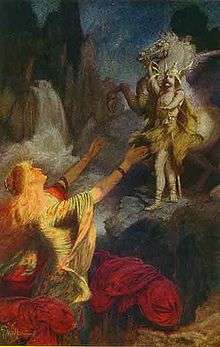
"Hundingbane's Return to Valhal" (1912) by Ernest Wallcousins.
Prose Edda
Valhalla is referenced in the Prose Edda books Gylfaginning and Skáldskaparmál.
Gylfaginning
Valhalla is first mentioned in chapter 2 of the Prose Edda book Gylfaginning, where it is described partially in euhemerized form. In the chapter, King Gylfi sets out to Asgard in the guise of an old man going by the name of Gangleri to find the source of the power of the gods. The narrative states that the Æsir foresaw his arrival and had prepared grand illusions for him, so that when Gangerli enters the fortress, he sees a hall of such a height that he has trouble seeing over it, and notices that the roof of the hall is covered in golden shields, as if they were shingles. Snorri then quotes a stanza by the skald Þjóðólfr of Hvinir (c. 900). As he continues, Gangleri sees a man in the doorway of the hall juggling short swords, and keeping seven in the air at once. Among other things, the man says that the hall belongs to his king, and adds that he can take Gangleri to the king. Gangleri follows him, and the door closes behind him. All around him he sees many living areas, and throngs of people, some of which are playing games, some are drinking, and others are fighting with weapons. Gangleri sees three thrones, and three figures sitting upon them: High sitting on the lowest throne, Just-As-High sitting on the next highest throne, and Third sitting on the highest. The man guiding Gangleri tells him that High is the king of the hall.[8]
In chapter 20, Third states that Odin mans Valhalla with the Einherjar: the dead who fall in battle and become Odin's adopted sons.[9] In chapter 36, High states that valkyries serve drinks and see to the tables in Valhalla, and Grímnismál stanzas 40 to 41 are then quoted in reference to this. High continues that the valkyries are sent by Odin to every battle, where they choose who is to die, and determine victory.[10]
In chapter 38, Gangleri says: "You say that all men who have fallen in battle from the beginning of the world are now with Odin in Valhalla. With what does he feed them? I should think the crowd there is large." High responds that this is indeed true, that a huge amount are already in Valhalla, but yet this amount will seem to be too few when "the wolf comes." High describes that there are never too many to feed in Valhalla, for they feast from Sæhrímnir (here described as a boar), and that this beast is cooked every day and is again whole every night. Grímnismál stanza 18 is then recounted. Gangleri asks if Odin himself eats the same food as the Einherjar, and High responds that Odin needs nothing to eat—Odin only consumes wine—and he gives his food to his wolves Geri and Freki. Grímnismál stanza 19 is then recounted. High additionally states that at sunrise, Odin sends his ravens Huginn and Muninn from Valhalla to fly throughout the entire world, and they return in time for the first meal there.[11]
In chapter 39, Gangleri asks about the food and drinks the Einherjar consume, and asks if only water is available there. High replies that, of course, Valhalla has food and drinks fit for kings and jarls, for the mead consumed in Valhalla is produced from the udders of the goat Heiðrún, who in turn feeds on the leaves of the "famous tree" Læraðr. The goat produces so much mead in a day that it fills a massive vat large enough for all of the Einherjar in Valhalla to satisfy their thirst from it. High further states that the stag Eikþyrnir stands atop Valhalla and chews on the branches of Læraðr. So much moisture drips from his horns that it falls down to the well Hvelgelmir, resulting in numerous rivers.[12]
In chapter 40, Gangleri muses that Valhalla must be quite crowded, to which High responds by stating that Valhalla is massive and remains roomy despite the large amount of inhabitants, and then quotes Grímnismál stanza 23. In chapter 41, Gangleri says that Odin seems to be quite a powerful lord, as he controls quite a big army, but he yet wonders how the Einherjar keep themselves busy when they are not drinking. High replies that daily, after they've dressed and put on their war gear, they go out to the courtyard and battle one another in one-on-one combat for sport. Then, when mealtime comes, they ride home to Valhalla and drink. High then quotes Vafþrúðnismál stanza 41. In chapter 42, High describes that, "right at the beginning, when the gods were settling" they had established Asgard and then built Valhalla.[13] The death of the god Baldr is recounted in chapter 49, where the mistletoe that is used to kill Baldr is described as growing west of Valhalla.[14]
Skáldskaparmál
At the beginning of Skáldskaparmál, a partially euhemerized account is given of Ægir visiting the gods in Asgard and shimmering swords are brought out and used as their sole source of light as they drink. There, numerous gods feast, they have plenty of strong mead, and the hall has wall-panels covered with attractive shields.[15] This location is confirmed as Valhalla in chapter 33.[16]
In chapter 2, a quote from the anonymous 10th century poem Eiríksmál is provided (see the Fagrskinna section below for more detail and another translation from another source):
What sort of dream is that, Odin? I dreamed I rose up before dawn to clear up Val-hall for slain people. I aroused the Einheriar, bade them get up to strew the benches, clean the beer-cups, the valkyries to serve wine for the arrival of a prince.[17]
In chapter 17 of Skáldskaparmál, the jötunn Hrungnir is in a rage and, while attempting to catch up and attack Odin on his steed Sleipnir, ends up at the doors to Valhalla. There, the Æsir invite him in for a drink. Hrungnir goes in, demands a drink, and becomes drunk and belligerent, stating that he will remove Valhalla and take it to the land of the jötunn, Jötunheimr, among various other things. Eventually, the gods tire of his boasting and invoke Thor, who arrives. Hrungnir states that Thor is under their protection, and subsequently he can't be harmed while in Valhalla. After an exchange of words, Hrungnir challenges Thor to a duel at the location of Griotunagardar, resulting in Hrungnir's death.[18]
In chapter 34, the tree Glasir is stated as located in front of the doors of Valhalla. The tree is described as having foliage of red gold and being the most beautiful tree among both gods and men. A quote from a work by the 9th century skald Bragi Boddason is presented that confirms the description.[19]
Heimskringla
Valhalla is mentioned in euhemerized form and as an element of remaining Norse pagan belief in Heimskringla. In chapter 8 of Ynglinga saga, the "historical" Odin is described as ordaining burial laws over his country. These laws include that all the dead are to be burned on a pyre on a burial mound with their possessions, and their ashes are to be brought out to sea or buried in the earth. The dead would then arrive in Valhalla with everything that one had on their pyre, and whatever one had hidden in the ground.[20] Valhalla is additionally referenced in the phrase "visiting Odin" in a work by the 10th century skald Þjóðólfr of Hvinir describing that, upon his death, King Vanlandi went to Valhalla.[21]
In chapter 32 of Hákonar saga Góða, Haakon I of Norway is given a pagan burial, which is described as sending him on his way to Valhalla. Verses from Hákonarmál are then quoted in support, themselves containing references to Valhalla.[22]
Fagrskinna
In chapter 8 of Fagrskinna, a prose narrative states that, after the death of her husband Eric Bloodaxe, Gunnhild Mother of Kings had a poem composed about him. The composition is by an anonymous author from the 10th century and is referred to as Eiríksmál, and describes Eric Bloodaxe and five other kings arriving in Valhalla after their death. The poem begins with comments by Odin (as Old Norse Óðinn):
- 'What kind of a dream is it,' said Óðinn,
- in which just before daybreak,
- I thought I cleared Valhǫll,
- for coming of slain men?
- I waked the Einherjar,
- bade valkyries rise up,
- to strew the bench,
- and scour the beakers,
- wine to carry,
- as for a king's coming,
- here to me I expect
- heroes' coming from the world,
- certain great ones,
- so glad is my heart.[23]
The god Bragi asks where a thundering sound is coming from, and says that the benches of Valhalla are creaking—as if the god Baldr had returned to Valhalla—and that it sounds like the movement of a thousand. Odin responds that Bragi knows well that the sounds are for Eric Bloodaxe, who will soon arrive in Valhalla. Odin tells the heroes Sigmund and Sinfjötli to rise to greet Eric and invite him into the hall, if it is indeed he.[24]
Sigmund asks Odin why he would expect Eric more than any other king, to which Odin responds that Eric has reddened his gore-drenched sword with many other lands. Eric arrives, and Sigmund greets him, tells him that he is welcome to come into the hall, and asks him what other lords he has brought with him to Valhalla. Eric says that with him are five kings, that he will tell them the name of them all, and that he, himself, is the sixth.[24]
-
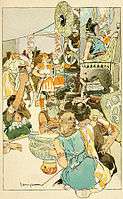
"Gylfe stood boldly before Odin" (1908) by Hamilton Wright Mabie.
-
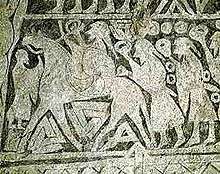
The 7th century Tängelgårda stone depicts a figure leading a troop of warriors all bearing rings. Valknut symbols are drawn beneath his horse.
-
The Stenbro picture stone on Gotland is one of several image stones that depict a dead man being received by a Valkyrie in the afterlife.
-
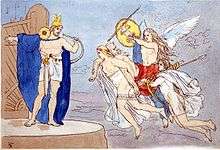
A depiction of valkyries encountering the god Heimdallr as they carry a dead man to Valhalla (1906) by Lorenz Frølich.
Locations
Multiple places have been named after Valhalla. These include:
- the Walhalla temple built by Leo von Klenze for Ludwig I of Bavaria between 1830–1847 near Regensburg, Germany, and
- the Tresco Abbey Gardens Valhalla museum built by August Smith around 1830 to house ship figureheads from shipwrecks that occurred at the Isles of Scilly, England, where the museum is located.[25]
- A crater, Valhalla, located on the planet Jupiter's moon Callisto, is named after the hall.
- Valhalla Borgen in Tivoli Gardens in Copenhagen, Denmark[26]
- Valhalla in Pleasure Beach Blackpool in Blackpool, England
Locations named after Valhalla also exist :
- North America :
- Valhalla, New York
- Valhalla Centre, Alberta
- Valhalla Golf Club in Louisville, Kentucky
- Lake Valhalla in Washington
- Mt. Valhalla in Chequamegon-Nicolet National Forest, Bayfield County, Wisconsin
- Walhalla, Michigan
- Walhalla, North Dakota
- Walhalla, South Carolina
- and Walhalla, Texas
- Walhalla, Victoria
- South Africa :
- Valhalla, Pretoria
-

The Walhalla temple above the Danube near Regensburg, Germany.
-
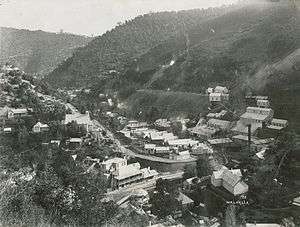
Walhalla, Victoria, Australia township in 1910
See also
Notes
- ↑ Orchard (1997:171–172).
- ↑ Larrington (1999:8).
- ↑ Larrington (1999:253–254).
- ↑ Larrington (1999:53).
- 1 2 Larrington (1995:55).
- 1 2 Larrington (1999:139).
- ↑ Larrington (1999:139–141).
- ↑ Byock (2005:10–11).
- ↑ Byock (2005:31).
- ↑ Byock (2005:44–45).
- ↑ Byock (2005:46–47).
- ↑ Byock (2005:48).
- ↑ Byock (2005:49-50).
- ↑ Byock (2005:66).
- ↑ Faulkes (1995:59).
- ↑ Faulkes (1995:95).
- ↑ Faulkes (1995:69).
- ↑ Faulkes (1995:77–78).
- ↑ Faulkes (1995:96).
- ↑ Hollander (2007:12).
- ↑ Hollander (2007:17).
- ↑ Hollander (2007:125).
- ↑ Finlay (2004:58).
- 1 2 Finlay (2004:59).
- ↑ Simek (2007:348), and from "Tresco Abbey Gardens Valhalla". Tresco in the Isles of Scilly UK. Tresco Estate. Retrieved 2008-09-06.
- ↑ "Valhalla Borgen" (in Danish). http://www.aok.dk. Retrieved 2009-07-08. External link in
|publisher=(help)
References
- Byock, Jesse (Trans.) (2006). The Prose Edda. Penguin Classics. ISBN 0-14-044755-5
- Faulkes, Anthony (Trans.) (1995). Edda. Everyman. ISBN 0-460-87616-3
- Finlay, Alison (2004). Fagrskinna, a Catalogue of the Kings of Norway: A Translation with Introduction and Notes. Brill Publishers. ISBN 90-04-13172-8
- Hollander, M. Lee (Trans.) (2007). Heimskringla: History of the Kings of Norway. University of Texas Press. ISBN 978-0-292-73061-8
- Larrington, Carolyne (Trans.) (1999). The Poetic Edda. Oxford World's Classics. ISBN 0-19-283946-2
- Orchard, Andy (1997). Dictionary of Norse Myth and Legend. Cassell. ISBN 0-304-34520-2
- Simek, Rudolf (2007) translated by Angela Hall. Dictionary of Northern Mythology. D.S. Brewer ISBN 0-85991-513-1
- Welch, Chris (2005). Led Zeppelin: Dazed and Confused: The Stories Behind Every Song. Thunder's Mouth Press. ISBN 978-1-56025-818-6
External links
| Wikimedia Commons has media related to Valhalla. |
